In today’s world, living in small spaces is common. Minimalist home decor for small spaces has become a key solution for making these spaces look great and work well. Whether you live in a small apartment or a tiny home, minimalist design can make your space better. It helps you create a calm and beautiful area that fits your life.
Principles of Minimalist Interior Design
Minimalist interior design is based on three key principles: simplicity, functionality, and efficiency. These principles help create spaces that look good, work well, and are perfect for daily life.
Simplicity
At the core of minimalist design is simplicity. It focuses on the essential parts of a space. This results in calm and clear areas. Neutral colors, clean lines, and no clutter let each item stand out.
Functionality
Functionality is the top priority in minimalist design. Spaces are made to meet specific needs. Furniture and layouts are chosen to use every inch wisely. This creates an organized and efficient space.
Efficiency
Efficiency is key in minimalist design. It aims to use every inch of space well. Smart lighting, personal touches, and decor placement add to the space’s order and flow.
By following simplicity, functionality, and efficiency, minimalist design makes welcoming spaces. These spaces are both beautiful and practical. They offer a peaceful, clutter-free place for living.
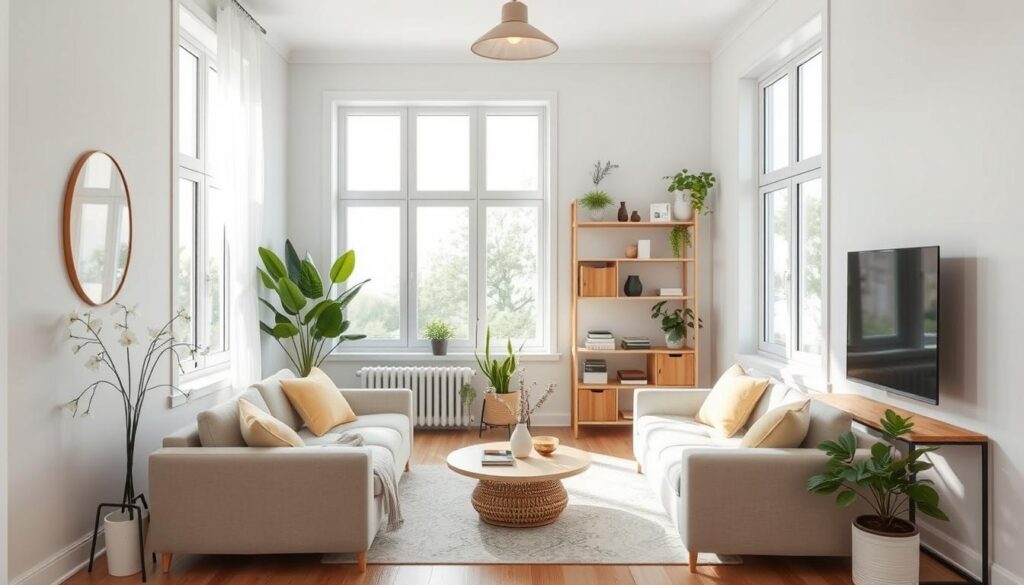
Understanding Minimalist Furniture
Minimalist furniture is all about simplicity. It has clean lines and simple shapes. This makes it stand out without being too fancy.
It’s made from natural materials like wood, glass, and metal. These materials give it a warm feel while keeping it modern.
The colors used are mostly black, white, and gray. This color scheme helps keep the focus on the furniture’s design. It makes the furniture look simple and useful.
Design Elements
Minimalist furniture focuses on being simple and useful. It has:
- Clean, geometric shapes
- Straight, uncluttered lines
- Lack of decorative details
- Focus on form and structure
Materials
It uses natural, high-quality materials. This gives it a warm, organic look. Common materials are:
- Wood (e.g., oak, maple, ash)
- Glass
- Metal (e.g., steel, aluminum)
- Plastic (e.g., polypropylene, acrylic)
Color Scheme
The colors are muted and simple. This lets the furniture’s design shine. Popular colors are:
| Color | Example |
|---|---|
| Black | 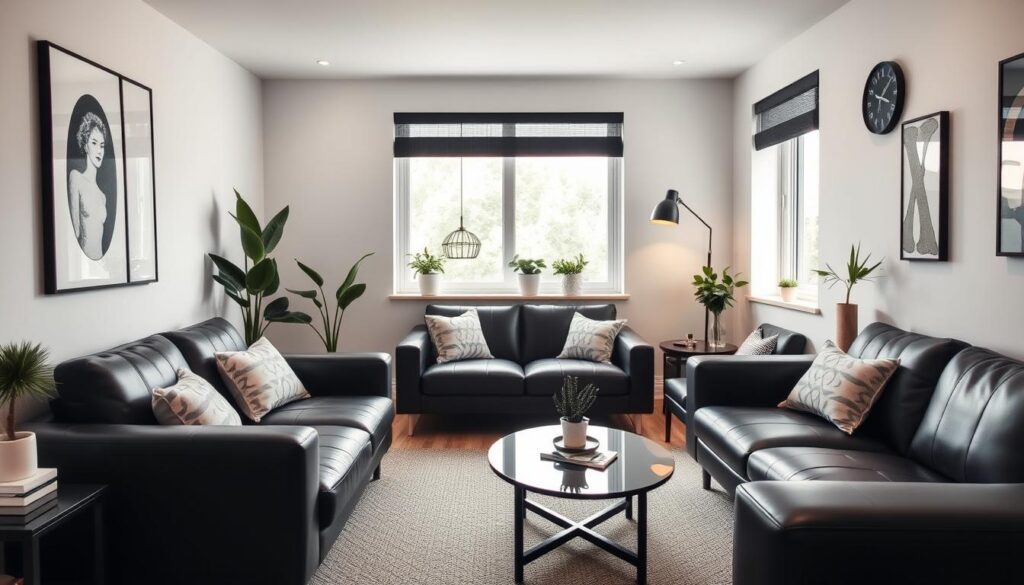 |
| White | 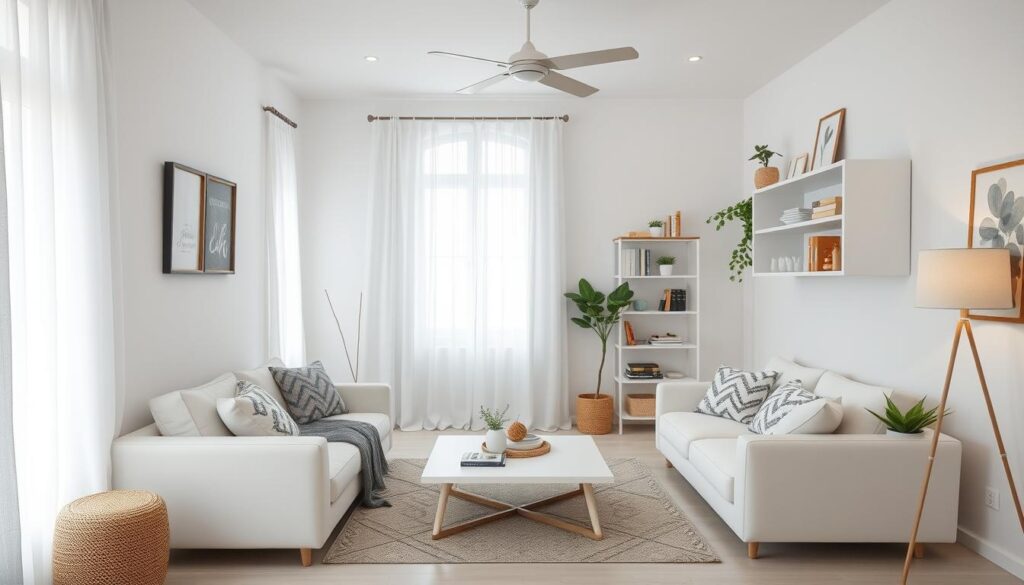 |
| Gray | |
| Earthy Tones | 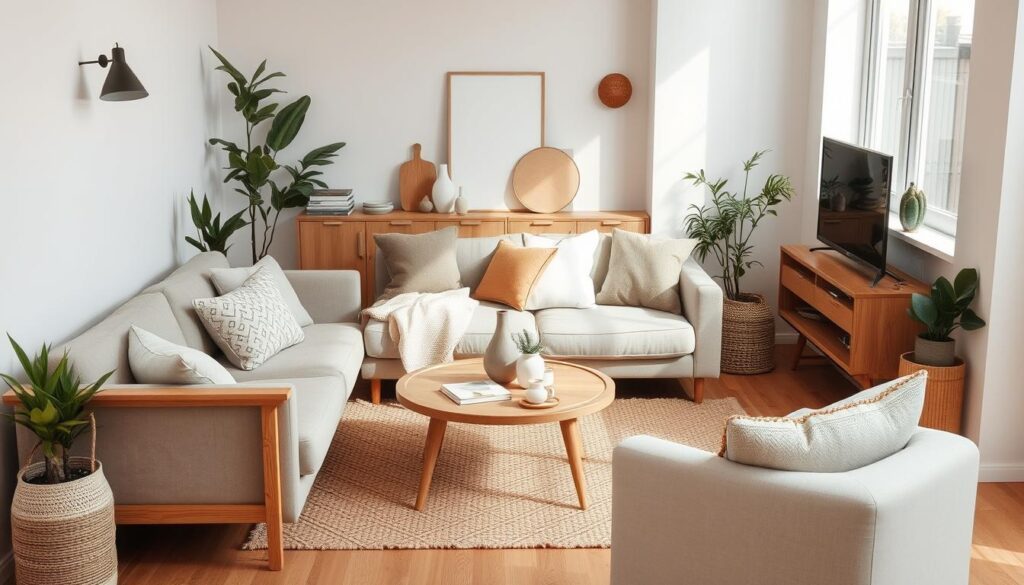 |
Choosing minimalist furniture creates a calm, simple space. It’s perfect for small areas because it’s both functional and stylish.
Key Benefits of Minimalist Furniture
Minimalist furniture brings many benefits to modern homes. It helps save space, looks great, and is easy on the wallet. It’s perfect for anyone looking to improve their living space.
One big plus of minimalist furniture is how it maximizes space. Its sleek designs make rooms feel bigger. This is especially helpful in small or busy areas.
Minimalist furniture also enhances aesthetics. Its clean lines and simple colors add elegance. This makes any room look better and feel more organized.
Another great thing about minimalist furniture is how easy it is to maintain. Its simple design means less dust and dirt. This saves time and effort, making your home feel more peaceful.
Lastly, minimalist furniture is cost-effective. Its design and materials are simpler, which means it’s often cheaper. This makes it easier to create a stylish home without spending a lot.
“A minimalist home is a calming oasis, free from the distractions and clutter that can weigh us down. It’s a space that allows us to focus on what truly matters.”

Smart Space-Saving Hacks and Multifunctional Furniture Solutions
Living in small spaces requires smart hacks to make your home comfortable and useful. Using appropriately sized furniture is key. Big furniture can make a room feel tight and messy. Choose furniture that fits the room well to keep it feeling open and airy.
Install a Murphy Bed
A Murphy bed is a great space-saver. These beds fold up against the wall, perfect for guest rooms or offices. They let you change the room’s use when the bed is up, making the space more versatile.
Make a Room Multipurpose
Take the Murphy bed idea further by making a room do more than one thing. For instance, a Murphy bed that folds up to show a home office or dining area is smart. It lets you use your space in many ways, making the most of every inch.
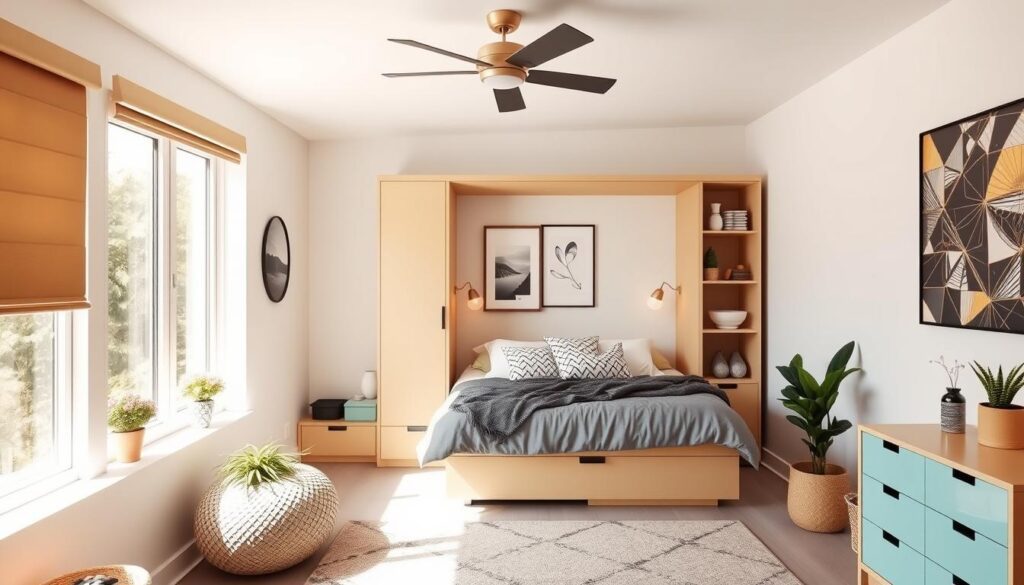
With a bit of creativity and planning, even tiny spaces can become useful and nice-looking. These hacks help you use your home’s space better, making it cozy and tidy.
Minimalist Home Decor for Small Spaces
Creating a minimalist home decor in small spaces can change everything. By focusing on simplicity, functionality, and efficient space use, you can make small areas feel bigger and more peaceful.
Neutral colors are key in minimalist design. White, cream, and soft pastels are popular for their calming effect. Many minimalist homes have white walls to follow current trends and make spaces feel open.
Open floor plans are another important feature. They blend rooms together and use natural light to make spaces feel bigger, even when they’re small.
The “less is more” idea is central to minimalist decor. It’s about choosing items that are simple and meaningful. Buying quality items is better than having a lot of cheap ones.
To get a minimalist look, start with a neutral base. Then add items in similar colors and textures. This keeps the space calm and consistent.

In living rooms, minimalist design often omits rugs, accent chairs, and end tables. Instead, it uses clean, functional furniture and a large piece of art for balance.
Dining rooms in minimalist homes use sleek, geometric furniture. They might also have shelves instead of cabinets to keep things tidy and show off valuable items.
Bedrooms in minimalist homes focus on calmness and hidden storage. Platform beds without frames and adding greenery are popular for their soothing effect.
“Minimalist design is not about deprivation, but about intentionality and focus. It’s about creating a space that is both functional and visually harmonious.” – Jane Doe, Interior Designer
Maximizing Space with Compact Furniture Solutions
Creating a functional and beautiful small-space living area is key. Using Compact Furniture Solutions is crucial. These pieces make the most of limited space, adding Multifunctional Decor and a Clutter-Free Interior.
Multifunctional Decor
Multifunctional furniture, like ottomans with storage or coffee tables with secret spots, is a game-changer. It turns small spaces into efficient and stylish areas. With these Compact Furniture Solutions, you can keep your space tidy and useful.
Clutter-Free Interior
Keeping your space clean and open is vital in small areas. Compact Furniture Solutions help hide items, making your home look great and feel calm. This approach makes your space more inviting and peaceful.
Choosing the right Compact Furniture Solutions is the secret to a great small living area. By focusing on Multifunctional Decor and a Clutter-Free Interior, you can turn a small space into a cozy and stylish retreat.
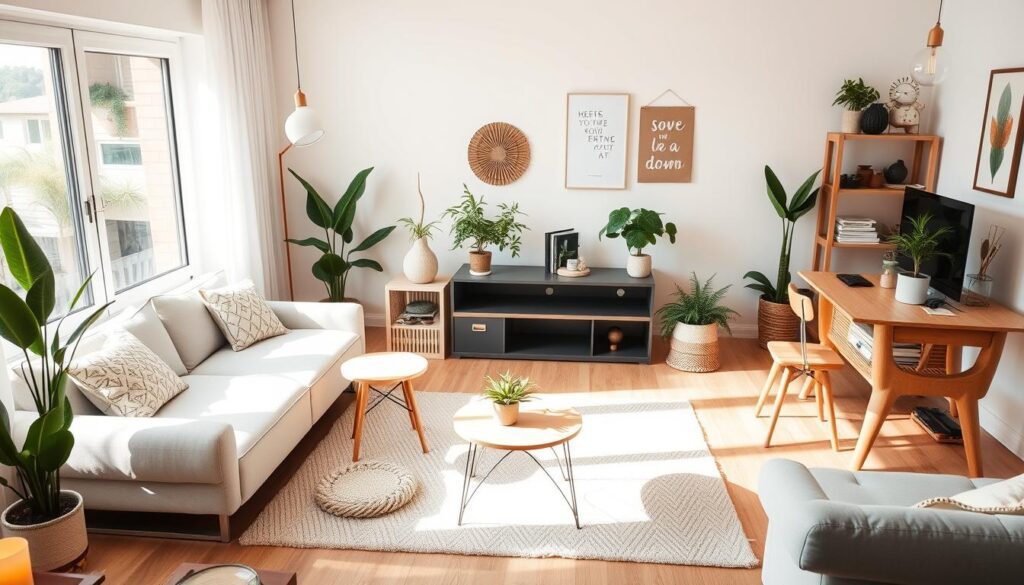
| Compact Furniture Solutions | Multifunctional Decor | Clutter-Free Interior |
|---|---|---|
| – Ottomans with hidden storage – Coffee tables with built-in compartments – Transformable furniture pieces – Wall-mounted furniture | – Versatile furniture that combines form and function – Minimizes clutter and maximizes functionality – Enhances the usability of small spaces | – Strategic organization and placement of furniture – Conceals unnecessary items – Promotes a clean and visually appealing environment – Fosters a calming and focused mindset |
Efficient Space Utilization Strategies
In the quest for maximizing limited living spaces, smart storage solutions and strategic use of blank areas can work wonders. From built-in shelving and hidden compartments to cleverly designed multifunctional furniture, the key is to approach every inch of your home with intentionality.
Smart Storage Solutions
Efficient space utilization begins with innovative storage ideas. Incorporate built-in shelving units that seamlessly blend into your walls, providing ample display and storage without consuming valuable floor space. Hidden compartments, such as drawers beneath window seats or under-bed storage, can also help minimize clutter and keep your belongings neatly tucked away.
Multifunctional furniture is another game-changer for small spaces. Look for pieces like ottomans with concealed storage, sofa beds that transform into guest accommodations, and coffee tables with hidden compartments. These versatile solutions maximize functionality while maintaining a clean, uncluttered aesthetic.
Use Blank Spaces Strategically
Don’t let those seemingly “blank” areas go to waste. Hallway niches, the space under the stairs, and even the wall behind your bed can be transformed into functional and visually appealing elements of your home’s design. Utilize these underutilized zones for storage, display, or even as a cozy reading nook.
By adopting a strategic approach to Efficient Space Utilization, Smart Storage Solutions, and the Strategic Use of Blank Spaces, you can unlock the full potential of your small living area. Create a harmonious, decluttered environment that feels both practical and inviting.
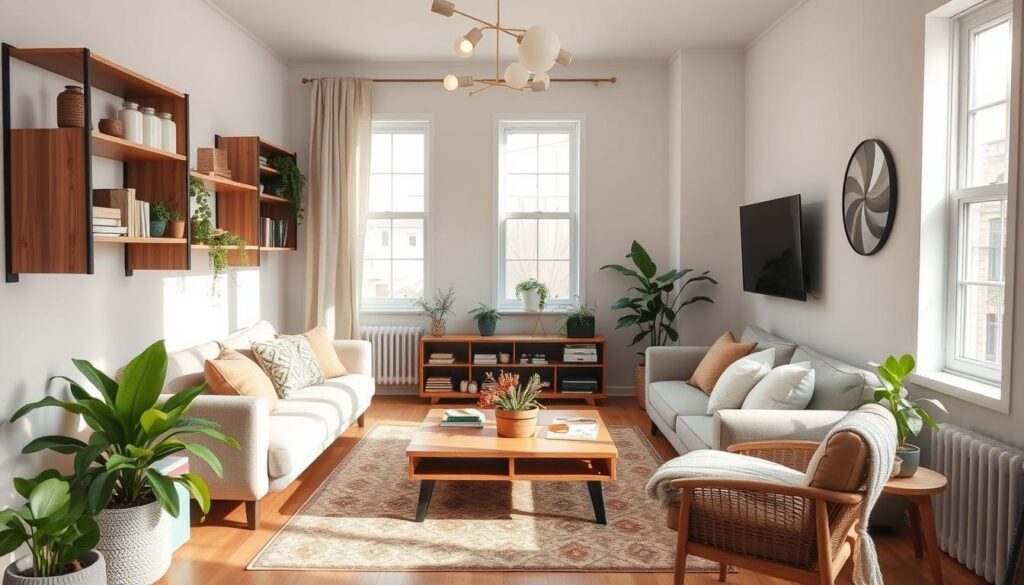
“Less is more when it comes to small space living. Focus on multipurpose furniture and hidden storage to maintain a clean, uncluttered aesthetic.”
Minimalist Aesthetic: Colors and Materials
The minimalist aesthetic focuses on simplicity. It uses neutral colors like whites, grays, and earthy tones. These colors create a calm and harmonious setting.
Materials like wood, glass, and metal add warmth and modernity. They highlight the beauty of simplicity through clean lines and quality craftsmanship.
Minimalist living rooms are simple and streamlined. A color palette of white and black gives a clean look. Large, simple furniture pieces add comfort without clutter.
It’s important to consider space scale in minimalist design. Multipurpose furniture and smart placement keep the room tidy. This approach makes the room feel open and spacious.
Midcentury modern design brings warmth to minimalist spaces. Using natural light and white space enhances openness. This creates a stylish and functional area.
The minimalist aesthetic values every choice. From colors to materials, it aims for a cohesive, stylish space. This space is simple yet functional.
Tiny Home Design: Going Big with Small Spaces
In Tiny Home Design or Small Spaces, sometimes bigger is better. Using large Bigger Decor Elements like big artwork or bold lighting can make a room look bigger. It’s more appealing than filling it with lots of small things.
Bigger Decor Elements for Small Rooms
For Small Spaces, think big with decor. A few bold, large pieces can make a tiny room feel grand. Hang a big mirror or a striking light to make the room feel taller.
A large artwork or a dramatic wall hanging can also make a space feel more special. These Bigger Decor Elements add interest and help keep the design simple. This way, you avoid clutter and keep the look clean.
By going big in Tiny Home Design, you can add luxury and style. The right big pieces can turn a small room into a beautiful and useful space.
Relentless Decluttering for a Serene Environment
Living a minimalist lifestyle means more than just picking furniture and decor. It’s about being dedicated to decluttering all the time. Keeping your home free of clutter is key to a serene and peaceful space. This constant decluttering helps you focus on what’s important and enjoy a calm home.
The 90/90 rule is a big part of minimalist living. It says to get rid of things you haven’t used in 90 days or won’t use in the next 90. This rule helps keep your space tidy and free of unwanted stuff.
Minimalism makes you think about your values, needs, and how you buy things. It’s about living more intentionally and sustainably. By decluttering and keeping your space calm, you can feel less stressed, more mindful, and clearer in your mind. This improves your overall health and happiness.
To make your minimalist home peaceful, choose quality over quantity in decor. Use neutral colors like whites, beiges, and grays to make small spaces feel open and bright. Natural light and simple window treatments also help create a calm atmosphere.
Being committed to relentless decluttering and a serene environment is vital in the minimalist lifestyle. By always getting rid of things you don’t need and keeping your space clean, you create a focused, peaceful, and healthy home.
For more budget-friendly tips, explore our article on Affordable Home Decor Ideas and create a minimalist look on a budget.
Conclusion
Homeowners can make small spaces look great with minimalist design. They use simple furniture and smart storage to make rooms look bigger. This way, even tiny homes can feel cozy and welcoming.
Living simply helps create a peaceful home. It’s about getting rid of clutter and choosing things that matter. This approach makes a space feel calm and personal.
Smart tech and flexible furniture are key to small space success. Using eco-friendly materials and vertical storage also helps. These ideas help make the most of every inch.
The secret to a minimalist home is careful planning. It’s about finding the right balance between looks and usefulness. This way, even small homes can be peaceful retreats, improving our daily lives.
FAQ
What are the core principles of minimalist interior design?
Minimalist design focuses on simplicity, functionality, and efficiency. It aims to reduce elements to their essence. This creates clear, uncluttered spaces.
Functionality means designing spaces for specific needs. This includes using multi-functional furniture and integrated storage. Efficiency uses every square inch of space with smart lighting and personal touches.
What defines minimalist furniture?
Minimalist furniture has clean, uncluttered designs. It often uses natural materials like wood, glass, and metal. This gives a warm, organic feel with a sleek look.
The colors are usually simple, like whites and grays. This lets the furniture’s form and structure stand out.
What are the key benefits of minimalist furniture?
Minimalist furniture saves space and looks great. It makes rooms feel bigger and looks elegant. Plus, it’s easy to clean and often cheaper.
What are some space-saving hacks for small living spaces?
For small spaces, choose the right-sized furniture. A Murphy bed is a smart choice for guest rooms or offices. It saves space when not in use.
Make rooms do double duty, like a Murphy bed that turns into a home office. This maximizes small spaces.
How can minimalist home decor transform small living spaces?
Minimalist decor can make small spaces feel bigger. It uses simplicity, functionality, and efficiency. This creates a calm, spacious feel.
Choose decor carefully, avoid clutter, and use every inch of space. This makes small areas feel more open.
What are some compact furniture solutions for small living areas?
Use furniture that does more than one thing. Ottomans with storage or coffee tables with hidden spots save space. Keeping things tidy also makes spaces feel bigger.
What strategies can be used for efficient space utilization in small living spaces?
Use smart storage and furniture to save space. Built-in shelves and hidden spots help keep clutter down. Use every inch, even in small areas.
Turn unused spots, like hallways or under stairs, into useful parts of your home. This makes your space more functional and pretty.
What defines the minimalist aesthetic, and how does it relate to small living spaces?
Minimalist style focuses on simplicity and careful color and material use. Neutral colors and natural materials create a calm, modern look. In small spaces, big decor items can make a room feel bigger and more interesting.
Why is decluttering important for a minimalist lifestyle in small spaces?
Minimalism is about more than just furniture. It’s about keeping your space clean and clutter-free. This creates a peaceful home environment.
Decluttering regularly is key to a minimalist lifestyle. It helps you focus on what’s important and enjoy your home’s calm atmosphere.
Source Links
- These Clever Small Home Ideas Make the Most of Every Room
- Minimalist design tips: How to make a small space look bigger – The Lifestyle Files
- The Ultimate Minimalist Furniture Guide for Small Spaces in 2024
- The Principles of Minimalist Interior Design | Minimalist House Design
- What is minimalist interior design style?
- Minimalist interior design – 10 tips I Blog
- Minimalist Interior Design: Everything You Need to Know About This Intentional and Pared-Down Style
- Key Minimalist Furniture Trends for Small Spaces in 2024
- 23 Examples of Minimalist Decor That Prove Less Is More
- A Guide to Creating a Minimalist Home – zen habits
- Key Minimalist Furniture Trends for Small Spaces in 2024
- 18 Creative Storage Ideas for Small Spaces to Get Organized
- 59 Small Space Decorating Tricks You Should Steal
- Here’s How to Design a Serene & Warm Minimalist Home | Spacejoy
- 25 Minimalist Decorating Ideas for a Calm and Clean Space
- 15 Small Living Room Layout Ideas That Maximize Space
- Maximizing Small Spaces: A Guide to Compact Living | TEAM Project Blog
- 15 Transforming Furniture Solutions for Small Spaces
- 31 Small-Space Solutions for Every Room in Your Home
- Small Space Living: Maximizing Storage with Functional Furniture
- Minimal Space, Maximum Style: Décor Hacks For Tiny Rooms
- 39 Minimalist Living Room Ideas For a Streamlined and Simple Look
- 31 Minimalist Living Room Ideas to Simplify Your Space
- 7 gorgeous minimalist small living room ideas — say bye-bye to bland
- 10 tiny house design ideas you can steal for any space
- Interior Design Tips for Tiny Homes + Small Spaces — SUKKHA INTERIOR DESIGN
- 18 Tiny Home Interior Design & Decor Tips | Extra Space Storage
- No title found
- Simplifying Spaces: Essential Minimalist Design Tips for Serenity | illustrarch
- Extreme Minimalism Unveiled: Discovering the Art of Living with Less — Lord Decor
- Minimalist Renovations: Transforming Small Spaces with Big Ideas
- Big ideas for small spaces: Minimalist decoration suggestions

